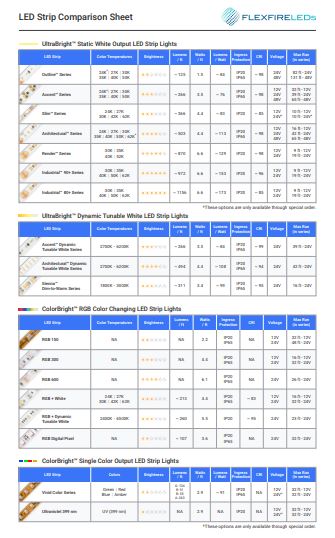How to choose the right LED strip light for your project
We believe that in order to make the right decisions while designing your project with LEDs, quick and accessible information is crucial.
There are a lot of confusing aspects of the LED industry in general. The LED market is full of suppliers that do little to verify their claims of LED longevity, brightness (lumen output), and quality.
Below you will find PDF sheets that compare our LED strip lights. This chart is helpful in visualizing the different specifications of our products on one page.
Click and download our comparisons between our different LED strips

View our LED Strip Light Comparison Chart
How to use the chart and select the best LED strip light for your project:
1. Educate yourself on the terminology
Lumen - Lumen is the measurement of brightness as perceived to the human eye. Because of incandescent lighting, we are all accustomed to using watts to measure the brightness of light. Today, we use lumen. Lumen is the most important variable when choosing which LED strip light you need to look at. Make sure you compare lumen output between LED strip lights before determining which one is best for your project.
CRI - Color Rendering Index (CRI) is the measurement of how colors look under a light source when compared with sunlight. The index is measured from 0-100, with a perfect 100 indicating that colors under the light source appear the same as they would under natural sunlight. When selecting white LED strip lights or light bars, make sure that the CRI is over 90 if you want colors to render vividly and truly.
Ingress Protection: IP is an acronym "Ingress Protection". It is a measurement of the protection an item will have against solid objects (dust, sand, dirt, etc.) and liquids. An IP rating is comprised of 2 numbers. The first number refers to the protection against solid objects (dust, etc) and the second number refers to protection against liquids. Learn more about what the numbers mean here.
Maximum Run length: One of the most important things to consider when installing LED Strip lights is the effect of what is called “Voltage Drop”. In DC circuits, voltage gradually drops as it travels along through a length of wire (or an LED strip light). So, with every foot of wire, the available voltage to each foot gradually decreases along the length of wire. This can lead to having one end of your strip lights being brighter than the other end.
2. Questions to ask yourself:
1. Do I want a light that: Just emits white? Changes colors? Changes between different color temperatures of white?
2. What color or CCT do you need?
2. What brightness is required?
3. Do I wish to have these on a dimmer?
4. Does your project require outdoor weather proofing?
5. How long do I want to run the strips? Will I have Voltage Drop?
Once you have completed these questions, use our free product selector tool!
3. Read the below page for a better understanding of the above principles.
90% of our customers found this page very useful in their decision making process for choosing Flexfire LEDs.
"Top four things to consider when purchasing LED strip lights"
4. Important Notes:
1. Make sure that you compare apples to apples when evaluating alternatives. We are here to help.
2. Compare lumen, CRI, Binning, warranty, PCB thickness, and TLCI when looking at other strips. Be very careful of any company selling strips without this important measurement. Ask for test reports if you are unsure.
3. Is it often wiser to choose an LED strip light that is brighter than you need. There are many dimming options available that enable you to have access to an extreme amount of light when you need it, or dim it down to a comfortable level. This will also extend the life of the LED strip light.
4. Consult a Design Specialist here at Flexfire LEDs to make sure you have the right product for your application!



